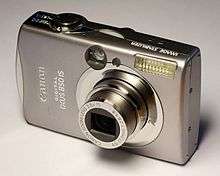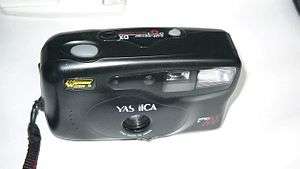Point-and-shoot camera
A point-and-shoot camera, also called a compact camera, is a still camera designed primarily for simple operation.[1] Most use focus free lenses or autofocus for focusing, automatic systems for setting the exposure options, and have flash units built in.
Point-and-shoots are by far the best selling type of separate camera, as distinct from camera phones. They are popular with people who do not consider themselves photographers but want easy-to-use cameras for snapshots of vacations, parties, reunions and other events. Point-and-shoot camera sales declined after about 2010 as smartphones overtook them in such uses.
Many superzoom compact cameras have optical zoom up to 30x and weigh less than 300 grams, much less than bridge cameras and DSLRs. Most of these compact cameras use small 1/2.3" sensors, but since 2008 a few non-interchangeable compact cameras use larger sensor such as 1" and even full frame format such as Sony Cyber-shot DSC-RX1R.[2] They prioritize intelligent Auto, but some high end P&S cameras have PSAM mode dial, Raw image format, and hot shoe. None have lens threads.[3]
As distinct from SLR
Point-and-shoot cameras are distinguished from single-lens reflex cameras (SLRs) in several respects: point-and-shoot film cameras, and many digital ones, use a viewfinder. The image that the photographer sees is not the same image that passes through the primary lens of the camera (that is, the lens that projects the image onto the film or, in the case of digital cameras, the image sensor). Rather, the image in the viewfinder passes through a separate lens.[4] SLRs, on the other hand, have only one lens, and a mirror diverts the image from the lens into the viewfinder; that mirror then retracts when the picture is taken so that the image can be recorded on the film or sensor. With this mechanism, pictures cannot be previewed on the LCD screens of most digital SLRs, although some manufacturers have found a way around this limitation. Digital cameras eliminate one advantage of the SLR design, as the camera's display image comes through the lens, not a separate viewfinder. Many smaller digital point-and-shoots of the 2010s omit the optical viewfinder.
With SLR cameras, it is important that the image in the viewfinder be the same image recorded by the film or sensor, so that the effect of the add-on lenses and filters can be seen by the photographer. Point-and-shoot cameras generally don't have such add-on devices, hence there is no such need.
The size limitations of compact and ultra-compact cameras, including digital ones, encourage the occurrence of photographic orbs — unexpected, typically circular artifacts that occur in flash photographs — where the short distance between the lens and the built-in flash decreases the angle of light reflection to the lens, directly illuminating the aspect of the normally sub-visible particles facing the lens and increasing the camera's ability to capture the light reflected off the particles.[5]
Camera types
The lowest-end point-and-shoot film cameras are similar to disposable cameras, but can be reloaded. These cameras have focus-free lenses, with fixed apertures. They may or may not have a light meter. Most have a wheel or lever for advancing the film and cocking the shutter, and a crank for returning the film to the canister for unloading. Because of the fixed apertures, models with flash have no way of controlling the exposure from the flash. Therefore, flash pictures have to be taken within a narrow range of distance from the subject.
Advanced models use automatic focus and have variable apertures. They all have light meters. They use electric motors to advance and rewind the film. They are much more versatile than the low-end models. They are also likely to have zoom lenses, more advanced auto-focus systems, exposure systems with manual controls, larger apertures and sharper lenses. They may have special lamps or pre-flash systems designed to reduce red eye in flash pictures of people.
Compact superzoom cameras or travel zoom cameras have zoom up to 30x, still shorter zoom than current bridge cameras, but more compact than bulky DSLR-shape bridge cameras, and both usually use 1/2.3" sensor.[6]
Sales decline
According to the NPD Group, up to end of November 2011 point-and-shoot cameras took 44 percent of photos, down from 52 percent in 2010, while camera-equipped smartphones took 27 percent of photos in 2011, up from 17 percent. Unit total sales of all types of point-and-shoot cameras declined by 17 percent year on year, but increased by 16 percent for cameras having optical zoom greater than 10x.[7] At the end of 2012, more than one brand have released point-and-shoot cameras with 24x optical superzoom[8] as compensation of sales decline and at the end of 2013 there were 30x optical point-and-shoot cameras.
P&S camera sales dropped by about 40 percent in year 2013 particularly inexpensive cameras, so Fujifilm and Olympus have stopped development of low-end P&S cameras and focused to develop mid and high-end cameras with more added value.[9]
Film types
Most film-based point-and-shoots made after the late 1980s use 35mm film. In the 1980s, 35mm was seen as a "professional" format due to the relative difficulty of loading and rewinding the film versus cartridge based formats such as 110 or disc film. The key innovations that made 35mm point-and-shoot cameras possible were automatic film loading and automatic advance and rewind. Advanced Photo System film was mildly popular in the 1990s. 126 film was also popular during the 1970s.
Name confusion
The terms "point and shoot" and "compact camera" are used differently in different parts of the world. In the UK point-and-shoot predominantly means a fully automatic camera, regardless of size or shape. A "compact camera" on the other hand, has a small body, regardless of any fully automatic capabilities. Thus a DSLR can have point-and-shoot modes, and some compact cameras are not designed for point and shoot operation, with the equivalent controls to a DSLR.
The use of "point-and-shoot" to mean a small or compact camera regardless of automation capabilities has long been predominant in the US, and in the 21st century it began spreading elsewhere.
Since 2012, the term of 'Compact System Camera' is frequently use, but it is a mirrorless interchangeable-lens camera with various sensor sizes, smaller compact body than DSLR, but has capabilities near, same or even better than DSLRs.[10]
References
- ↑ Brittanica Article
- ↑ Jason Schneider. "Game-Changing, Large-Sensor Point-and-Shoot Cameras". Retrieved November 7, 2016.
- ↑ Cliff Smith. "Sony Cyber-shot HX50 review". Retrieved March 1, 2015.
- ↑ http://www.wujimedia.com/2009/11/point-and-shoot-v-dslr-cameras-part-i/
- ↑ "The Truth Behind 'Orbs'".
- ↑ Joshua Goldman. "Compact megazooms compared (roundup)". Retrieved April 29, 2014.
- ↑ "Smartphones killing point-and-shoots, now take almost 1/3 of photos". December 22, 2011.
- ↑ "Top 10 Best Pocket Zoom Digital Cameras". November 26, 2012.
- ↑ Reiji Yoshida (Dec 30, 2013). "Mirrorless cameras offer glimmer of hope to makers". Retrieved December 31, 2013.
- ↑ Martin Bailey. "What is a compact system camera?". Retrieved February 27, 2014.
See also
| Wikimedia Commons has media related to compact cameras. |

